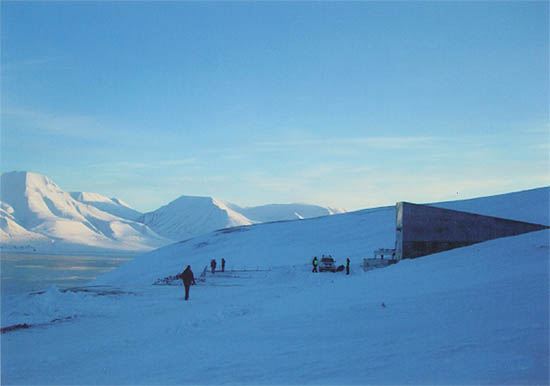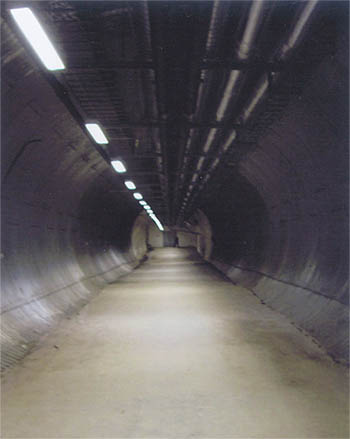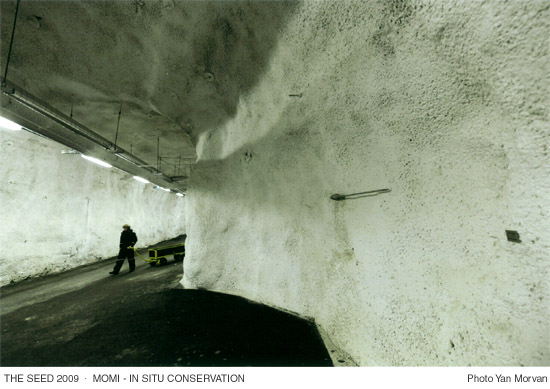 I
introduced a sculpture by Mitsuaki Tanabe in the May 21 edition of this newspaper
(no. 1152, page 2). It was A seed of wild rice -
MOMI - 2008, a monument installed in the headquarters building of FAO, the
Food and Agriculture Organization of the United Nations. The artist himself attended
the unveiling ceremony. It was held on April 1 last year, soon after the February
26 opening of the Svalbard Global Seed Vault, constructed in permafrost above
the Arctic Circle by the Global Crop Diversity Trust (GCDT), an independent organization
associated with FAO, and the Norwegian government. I
introduced a sculpture by Mitsuaki Tanabe in the May 21 edition of this newspaper
(no. 1152, page 2). It was A seed of wild rice -
MOMI - 2008, a monument installed in the headquarters building of FAO, the
Food and Agriculture Organization of the United Nations. The artist himself attended
the unveiling ceremony. It was held on April 1 last year, soon after the February
26 opening of the Svalbard Global Seed Vault, constructed in permafrost above
the Arctic Circle by the Global Crop Diversity Trust (GCDT), an independent organization
associated with FAO, and the Norwegian government.
 Tanabe's
sculpture, A seed of wild rice - MOMI, is an enlarged, symbolic representation
of the basic form of a wild rice seed, the end product of ideas and actions carried
out over a period of approximately 20 years. The installation of this sculpture
at the headquarters of the United Nations organization in charge of world food
problems means that the wild rice seed has been accepted as a universal symbol
of food crops grown on the planet Earth. Tanabe's
sculpture, A seed of wild rice - MOMI, is an enlarged, symbolic representation
of the basic form of a wild rice seed, the end product of ideas and actions carried
out over a period of approximately 20 years. The installation of this sculpture
at the headquarters of the United Nations organization in charge of world food
problems means that the wild rice seed has been accepted as a universal symbol
of food crops grown on the planet Earth.
 Tanabe
had a strong desire to visit the seed vault, which is located on the island of
Spitsbergen, one of the Svalbard Islands. The construction costs for the vault
were paid by the government of Norway, and it was designed as an ultimate safety
measure by GCDT, based on the idea that diversity is a fundamental principle of
agriculture in improving food productivity and preparing for a future food crisis.
The vault can accommodate more than 3 million kinds of seeds. The sealed boxes
inside can only be opened by representatives of the countries that own the seeds.
Tanabe made a proposal through the staff of the GCDT headquarters and the Norwegian
government organization he had met in Rome. He proposed to make a sculpture on
the theme of wild rice seed for the seed vault, expressing another of his themes,
in-situ conservation of wild rice. Tanabe
had a strong desire to visit the seed vault, which is located on the island of
Spitsbergen, one of the Svalbard Islands. The construction costs for the vault
were paid by the government of Norway, and it was designed as an ultimate safety
measure by GCDT, based on the idea that diversity is a fundamental principle of
agriculture in improving food productivity and preparing for a future food crisis.
The vault can accommodate more than 3 million kinds of seeds. The sealed boxes
inside can only be opened by representatives of the countries that own the seeds.
Tanabe made a proposal through the staff of the GCDT headquarters and the Norwegian
government organization he had met in Rome. He proposed to make a sculpture on
the theme of wild rice seed for the seed vault, expressing another of his themes,
in-situ conservation of wild rice. |
 His
proposal was accepted and on February 26 of this year, the anniversary of the
completion of the Global Seed Vault, he had the opportunity of visiting the vault
at the invitation of the Norwegian government. The symbolic sculpture was attached
to the wall of the tunnel in front of the vault in a place called the Svalbard
Tube, at the point where the tunnel moving straight in from the entrance meets
another tunnel crossing it at right angles. The temperature at the site is four
degrees below zero. It is a place that people pass whenever they take seeds in
or out. The sculpture is 120 centimeters long and, like most of Tanabe's other
sculptures, made of stainless steel. The title is The Seed 2009 Momi - In -
Situ Conservation. It advocates the importance of the idea of in-situ conservation,
which represents a very different approach to the preservation of plant species
than the seed vault. Tanabe believes that both approaches are necessary. They
must be used in tandem, like two wheels on the same vehicle, in order to assure
continued food production and crop diversity. His
proposal was accepted and on February 26 of this year, the anniversary of the
completion of the Global Seed Vault, he had the opportunity of visiting the vault
at the invitation of the Norwegian government. The symbolic sculpture was attached
to the wall of the tunnel in front of the vault in a place called the Svalbard
Tube, at the point where the tunnel moving straight in from the entrance meets
another tunnel crossing it at right angles. The temperature at the site is four
degrees below zero. It is a place that people pass whenever they take seeds in
or out. The sculpture is 120 centimeters long and, like most of Tanabe's other
sculptures, made of stainless steel. The title is The Seed 2009 Momi - In -
Situ Conservation. It advocates the importance of the idea of in-situ conservation,
which represents a very different approach to the preservation of plant species
than the seed vault. Tanabe believes that both approaches are necessary. They
must be used in tandem, like two wheels on the same vehicle, in order to assure
continued food production and crop diversity.
 This
vault is managed jointly by GCDT, the Nordic Genetic Resource Center (Nor Gen),
and the Norwegian government. The project was first conceived 20 years ago in
response to the nuclear power plant accident at Chernobyl, which occurred in April
1986. One is amazed at this realistic venture in crisis management designed to
deal with the dangers posed by nuclear power by the country in charge of the Nobel
Peace Prize. The installation of Tanabe's sculpture is an artistic contribution
to this effort by a Japanese artist, a person from Asia. Contributions within
a professional field are important, but assistant from outside the field is also
appreciated in a field like this. Art cannot solve any of these problems, but
it makes it possible for the person who sees it to gain a comprehensive understanding
in an instant. This
vault is managed jointly by GCDT, the Nordic Genetic Resource Center (Nor Gen),
and the Norwegian government. The project was first conceived 20 years ago in
response to the nuclear power plant accident at Chernobyl, which occurred in April
1986. One is amazed at this realistic venture in crisis management designed to
deal with the dangers posed by nuclear power by the country in charge of the Nobel
Peace Prize. The installation of Tanabe's sculpture is an artistic contribution
to this effort by a Japanese artist, a person from Asia. Contributions within
a professional field are important, but assistant from outside the field is also
appreciated in a field like this. Art cannot solve any of these problems, but
it makes it possible for the person who sees it to gain a comprehensive understanding
in an instant.
|







